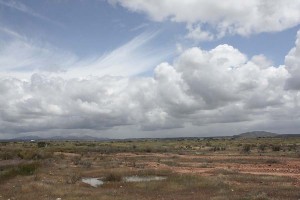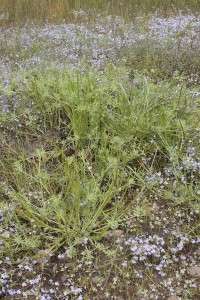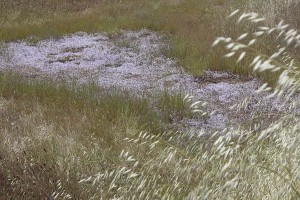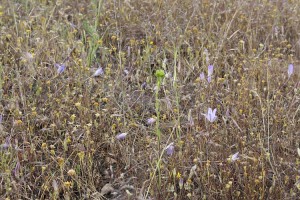On the recent outing to The Tunnels we took a little detour to view some vernal pools adjacent to Del Mar Mesa.
The area is a patchwork of land administered by several agencies. But the basic message at most of the parcels is: Sensitive Habitat, Keep Out.
Unfortunately, to the basic American pioneer mindset, “Keep Out” is a message to be resisted. The barricade to the right of this photo is fairly famous locally in commemorating the lengths that some people will go to in order to circumvent a regulation that they perceive to be too draconian. On a dark and stormy night (or it might have been in broad daylight on a clear morning, I’m not sure of the details) a vandal stole a bulldozer and drove it here to tear out the barricade. The vandal wasn’t able break through, but the barrier still shows the signs of the struggle.
Other fences were more easily defeated.
On the day we were out the rangers who were with us spent most of their time talking to the occasional hiker and the frequent mountain biker, explaining that the area was off limits. I guess the lifespan of a fence closing off a trail popular with mountain bikers is right up there with the lifespan of biology lab fruit flies. Most of the cyclists are respectful, but there are a few libertarian rednecks with wirecutters out there.
Once common in the county the vernal pool habitat is now one of the rarest. A nice flat spot that collects winter rains is also a nice flat spot to build your subdivision.
Today, in many of the pools that are left, you can watch the accelerated seasonal cycles. Tadpoles are pretty common, trying their hardest to reach amphibian puberty before the pool dries up.
Much less common are these, San Diego fairy shrimp, Branchinecta sandiegonensis, a critter that’s on the federal endangered species list. Your almost more likely to find them in vehicular tire ruts than in natural vernal pools.
Spike rush, Eleocharis montevidensis, emerging from the translucent water. It’s a common vernal pool plant.
And with this plant we return to the federal endangered species list. This is San Diego button celery, Eryngium aristulatum var. parishii. You’ll find it in standing water, like these plants. But it’s also happy setting up household adjacent to the pools, growing so prolifically that you’re likely to be surprised that it’s endangered. It’s one of those classic cases where a plant is rare mainly because its habitat is being obliterated.
Okay, okay, these photos are probably a little artsy and not particularly useful for identifying the plant…
I don’t begin to profess to know everything there is to know about these environments, but it’s pretty cool to check them out when you get the chance.
More information:
[ at the California Chaparral Institute ]
[ City of San Diego Vernal Pool Inventory ]
[ My April 25, 2010 trip to Miramar Mounds National Natural Landmark ]

























